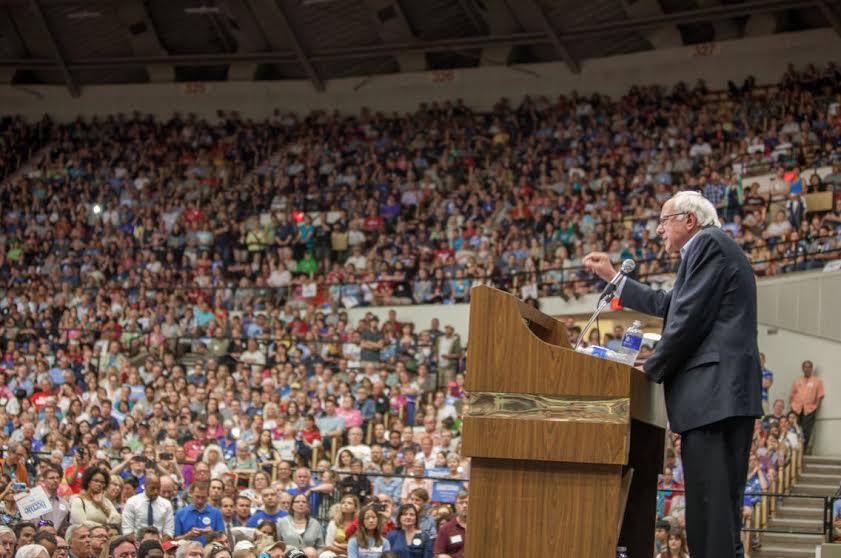Article by members of Socialist Alternative, the sister organisation of the Socialist Party in the US, on the Bernie Sanders’ challenge and how a new party for the 99% can be built.
Bernie Sander’s political revolution will be strangled if it remains imprisoned within the corporate-controlled Democratic Party. Sanders needs to run all the way through November and lay the groundwork for a new party of the 99%.
In the aftermath of Clinton’s decisive victories in South Carolina and most Super Tuesday states, Bernie Sanders’ campaign stands at a crossroads. Even as he reaches new heights of popular support in national polls – topping Clinton in several – it’s becoming increasingly clear that Sanders’ hopes for victory within the corporate-dominated Democratic Party primaries is extremely unlikely to succeed.
Pointing to Clinton’s 200+ earned delegate lead after Super Tuesday, the respected polling analysts at FiveThirtyEight.com quipped that “something truly crazy would have to happen for Sanders to win the nomination.”
Millions are naturally asking: How can they be coronating Clinton already, when national polls have Bernie neck-and-neck with Hillary, and when the vast majority of the country hasn’t even voted yet?
In answer, the talking heads in the corporate media are again rolling out their tired arguments about how Bernie Sanders and his democratic socialism are just too far left for American voters. In fact, Sanders campaign has received enormous support and far more grassroots enthusiasm than Clinton. The problem is not Bernie’s left-wing, working-class policies, it is that the big business Democratic Party is profoundly hostile terrain for such a campaign.
The Democratic Party primary elections are, by design, skewed to favor the pro-capitalist establishment that dominates the party. Especially since the redesign of the process after the social upheavals of the 1960s and 1970s, the entire primary process – from the super delegates to front-loading the more conservative southern states – is designed as an undemocratic firewall against left insurgent campaigns.
An Historic Campaign
Despite challenging Clinton in an electoral terrain stacked against left and working-class forces, Bernie Sanders’ campaign has achieved stunning, historic successes. Overcoming a near blackout in the corporate media throughout 2015, using mass rallies and social media, Sanders went from single-digit support in national polls to a dead-heat with Clinton by early February.
Bernie’s campaign has captured the imagination and raised the expectations of millions. It has demonstrated that it is possible to build a viable grassroots political revolution, completely independent of corporate cash, and capable of challenging the corporate stranglehold over politics.
Among young people – including young women who were “supposed” to flock to Clinton – Sanders’ call for a political revolution and socialist policies – like free higher education – has won overwhelming support. Sanders raised $42 million in February alone from a record-setting 1.4 million individual donors, outperforming Clinton for the second month in a row (not including the her unlimited Super PAC donations). This is utterly unprecedented for a candidate who refuses corporate contributions.
The grassroots movement behind Bernie wants to fight on, fueled by a healthy determination to overcome all obstacles. This is the spirit driving Socialist Alternative members across the country who have mobilized thousands through #MarchForBernie actions, “Labor for Bernie” activities, public debates, and mass community outreach.
Despite these dramatic successes, the Sanders campaign has failed to win over any significant section of the Democratic Party establishment to challenge Wall Street’s domination of their party. Especially revealing is the failure of Senator Elizabeth Warren to endorse Sanders. In this negative sense, the Sanders campaign is re-affirming what Socialist Alternative has long argued: Building a new mass party for working people is a far more viable project than transforming the Democrats from a party of big business into a vehicle to fight for working class interests.
How is Clinton Winning?
We argued in our previous articles that for Sanders to win, it would require an historic and unprecedented upsurge in voter turnout in the primaries, especially from young voters. This could only happen as part of a massive social upheaval and politicization of U.S. society.
So far the voter turnout has not in any way reached such proportions. The biggest factor favoring Clinton in this regard remains the deep alienation and disgust most workers and young people feel toward “politics,” a mood created by the repeated failures of the Democratic and Republican parties themselves. Most workers and young people won’t even start paying attention until the last months of general election. The minority who do vote in the primary skew heavily toward an older, wealthier, and loyally Democratic electorate.
It would be a fundamental mistake to allow this unrepresentative minority of voters to block the Sanders campaign from reaching a majority of working people in the general election with his far-reaching message.
On the terrain of the electorate participating in the primaries, the weight of the Democratic Party machine has a major impact. The establishment of elected officials, party insiders, and wealthy donors use their power and links to influence unions, civil rights and community groups, and church leaders to turn out their base.
This influence was shown graphically by the role the vast majority of union leaders played in mobilizing the power of labor behind the candidate of the Democratic Party machine without any serious opportunity for their members to debate or decide. While tens of thousands of the most active and fighting union members resisted this top-down effort, and Sanders eventually won several important union endorsements, it was not enough. In the end the power of the labor movement was a key factor in Clinton’s early wins in Iowa, and especially Nevada, which served to reverse Sanders momentum.
The power of the mass media is deployed to undermine anti-corporate campaigns and prop up establishment candidates like Clinton. From the media’s sensationalized coverage of Trump to their policy of ignoring or negatively covering Sanders, their election coverage is a textbook example of the power of the corporate media to shape public opinion.
Only through building up organized class conscious forces – independent working class movements, political parties, and media – can the power of the corporate media be systematically undermined on a mass scale.
On top of all this is the colossal mountain of Wall Street and corporate donations amassed by Clinton and her Super PACs. Despite the historic success of Sanders amassing over four million individual donations, Clinton’s virtually unlimited supply of corporate cash remains a major institutional advantage.
Time to Draw Conclusions
When Sanders launched his presidential bid last year, Socialist Alternative welcomed his campaign’s bold pro-worker message. At the same time we argued that Bernie was “making a fundamental mistake by running in the Democratic Party primary. Instead… he should run as an independent to help build a political alternative to the corporate-owned political parties. There is a glaring contradiction between Sanders’ call for a political revolution against the billionaire class and attempting to carry that out within a party controlled by that same billionaire class.”
Despite our clear disagreement with Sanders decision to run in the Democratic Party, we did not stand aside from his campaign or denounce it from the sidelines, as unfortunately many on the socialist left did. Instead, we worked in a non-sectarian fashion to support Bernie’s left-wing campaign while openly raising our political disagreements along the way. Meanwhile Sanders and his supporters tested out their strategy of trying to take over the Democratic Party.
While it is true that Sanders was able to reach a mass audience by running in the Democratic primaries and participating in the televised debates with Clinton, it is now increasingly clear that this experiment will fail. Despite the historic scale of Sanders’ challenge, the corporate establishment retained firm control of their party and are proving capable of denying Sanders the nomination.
Sanders strategy of trying to carry out a political revolution through the Democratic Party has now been tested. We must face up to the reality that it will not work. It’s time for Bernie, and more importantly, for his supporters, to draw all the necessary conclusions from this experience. If the movement does not break free from the straightjacket of the corporate-controlled Democratic Party it will be used as a left-wing prop for the Walmart, Wall Street, and pro-war Clinton campaign.
As we wrote when Bernie launched his campaign: “Sanders has said he will endorse the Democratic nominee, which is very likely to be Hillary Clinton … This will mean that those mobilized by Sanders will be told to support a pro-corporate Democrat, the exact opposite of a ‘revolution’ against the ‘billionaires and oligarchs.’ This could result in the demoralization of those mobilized by the idea of fighting corporate power and the loss of a historic opportunity.”
The impact of the millions mobilized for a political revolution in Sanders’ campaign against the billionaire class being pushed to embrace a candidate of the billionaire class will mean the demoralization, demobilization, and shipwreck of the movement. Bernie Sanders’ campaign has opened up the best potential in decades to build an ongoing political movement to challenge the corporate establishment of both major parties. But this will be tragically undermined unless we get organized – independent of the Democratic Party – to continue and deepen the political revolution, through November and beyond.
That’s why Socialist Alternative has consistently called on Sanders to run all the way through November, regardless of the outcome of the Democratic Party’s rigged primaries. If Sanders is checked within the Democratic primaries, as is increasingly likely, he will need to continue the fight by running as an independent or by appealing to Jill Stein and the Green Party to join their ballot line, rather than allowing the movement behind him to be imprisoned within the corporate-controlled Democratic Party.
Of course, even if Sanders is heading toward defeat in the primaries, we still want to see the maximum vote for his campaign and as many primary victories as possible to bring further pressure on the establishment and to maintain the mobilization for Sanders’ program. Within this ongoing mobilization, the discussion about the direction of the campaign can and must develop.
Stopping Trump and the Right
The central objection raised against Sanders running as an independent — Bernie himself has rejected this — is the threat of acting as a “spoiler,” of dividing the vote and allowing a Republican to win. And with Trump seen as the likely Republican nominee, the determination of millions of workers, people of color, women, and young people to do everything possible to push back the far-right threat is completely understandable.
The problem is, Hillary Clinton is just about the worst possible candidate imaginable to cut across the right-wing, anti-establishment populism of Donald Trump. Alongside the Bush family, the Clinton political dynasty is the living symbol of establishment politics in America. There is a reason most polls show Clinton losing, or neck-and-neck in matchups with the leading Republican candidates! It’s the same reason that, after Obama bailed out Wall Street, the Tea Party Republicans made sweeping gains as the dominant voice, however distorted, appearing to express popular anger with the special interests that corrupt politics.
So far, Sanders “democratic socialism” has captured broader anti-establishment support than Trump’s hateful right-populism. If Sanders attempts to funnel his supporters behind Clinton’s Wall Street campaign it will allow Trump to appear as the only anti-establishment voice in the general election, when tens of millions more will begin tuning in.
Sanders has a political responsibility to run in the general election, both to provide a pro-worker alternative to the corporate candidates, and to cut across Trump’s anti-establishment appeal. As we have already seen, alongside the traditional Democratic Party base, Sanders would draw support from independents and even some Republicans who are repelled by Clinton’s establishment ties. If Sanders refuses to run in the general election, intentions aside, it would be a fundamental failure of leadership on his part, and would, in practice, serve to strengthen Trump’s appeal.
Sanders has said he will not run independently because he does not want to be a “spoiler.” But why not at least explore a run in all the “safe” states (the vast majority of uncontested states that will clearly be won by the Democratic or Republican candidate)? Socialist Alternative would welcome a debate on the left on the pros and cons of such a challenge. A Sanders campaign through November, even if just running all out on the ballot in 40 states or more, could lay the foundations for a new mass party of working people, an historic step forward that would leave behind an organized force to continue the struggle after 2016.
We have an historic opportunity to launch a new party, that runs left candidates who reject corporate cash and pledge to use their positions to mobilize grassroots power to win a working-class agenda like $15 an hour, an end to mass incarceration, free education, and single-payer health care. Bernie’s campaign has already proven the potential exists for a new mass left party that could dramatically change of the face of American politics, especially if linked to a discussion on socialist change, helping to open a new era of social struggle.
Both the threat from the right, and the potential to rebuild a powerful independent left, demands that the movement behind Bernie refuses to be imprisoned within the Democratic Party. We must stay organized and continue the fight for a political revolution through November and beyond, laying the basis for a new party for working people.












